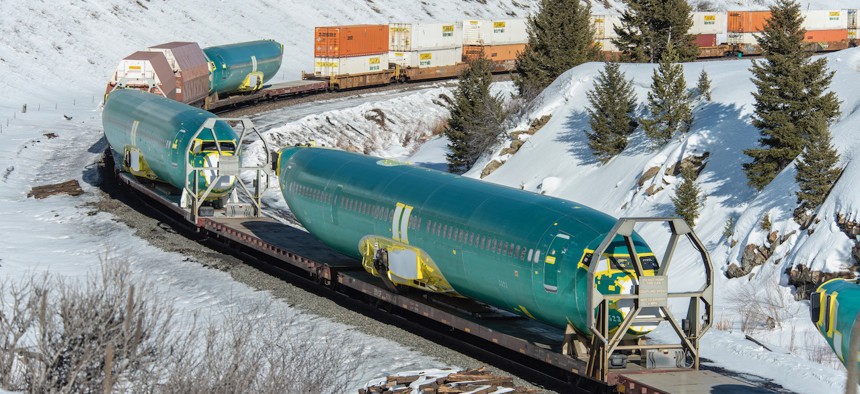
Boeing 737 Max 8 fuselages manufactured by Spirit AeroSystems in Wichita, Kansas, are transported on a BSNF train heading west over the Bozeman Pass in March 2019. William Campbell-Corbis/Getty Images
Major Aerospace Supplier Spirit AeroSystems Looks to Expand Military, Space Business
Company executives see the company playing a larger role in designing hypersonic weapons and next-generation aircraft.
In the early months of the coronavirus pandemic, as airlines grounded fleets and canceled buys of new aircraft, planemakers Boeing and Airbus were the focus of much of the attention. But Spirit AeroSystems, a key supplier to both, was hit extraordinarily hard.
The Wichita, Kansas-based company, probably best known for building the green airliner fuselages, was already dealing with Boeing’s suspension of 737 Max production a year earlier, following two deadly crashes. Then the pandemic hit. In all, the company laid off more than 5,000 employees.
Seeing how dependent it was on its commercial business, executives decided Spirit needed a more diverse business—one that included more military work. In the next 16 months, executives have come up with a plan that includes becoming a key supplier of hypersonic weapons and space systems to the large defense companies.
“We're able to offer the defense contractors the ability to design, not just structural things, but also subsystems and even deeper into the product ... and do the integration of all those things,” Spirit AeroSystems Defense & Space President Duane Hawkins said in a July interview.
The outlook at Spirit is much better today than two years ago, as airlines have started ordering planes again. The company recalled many of the workers it laid off in 2020 and is now planning to hire an additional 2,600 people in the coming years as airline demand for new planes increases—especially for narrowbody aircraft largely used for domestic flights.
“While we were always committed to diversifying our portfolio to defense, [the pandemic and Max grounding] probably reenergized us even more in realizing how exposed we are without having a diversified portfolio,” Hawkins said. “That's when we really, really kind of double down on our efforts.”
Among the moves was to hire Joshua Boehm as vice president of defense business development and strategy. Boehm had spent nearly 20 years working for defense firms BAE Systems, Raytheon, and Booz Allen Hamilton, and adding him was a move to “be a little bit more aggressive, and come up with a strategy that is long term,” Hawkins said.
The goal is to get the company to the point where 40 percent of its business is commercial, 40 percent defense, and 20 percent aftermarket work.
“We have a strategy now that we think will work for us for the next several decades,” Hawkins said. “It has flexibility in there to accommodate any changes.”
Spirit executives believe the way it approaches business and production methods makes it attractive to the Pentagon and to defense companies.
“We're able to actually go to transition from design to production, rather quickly ... maybe faster than typical in the defense world,” Hawkins said. “That's because we're designing with production in mind.”
The company now has “several hundred” engineers with security clearances, up from less than 100 “just a few years ago,” Hawkins said. The security clearances allow the engineers to work on classified military projects.
The large prime contractors are already relying on Spirit more, Boehm said. Spirit is a major supplier to several high-priority weapons projects, including the Air Force B-21 stealth bomber, Marine Corps CH-53K heavy lift helicopter, and the Navy P-8 maritime patrol aircraft. Boeing recently hired the company to build new pylons and nacelles for engines that will be installed on the B-52 bomber.
Currently, defense and space projects account for 18 to 20 percent of Spirit’s workload—up from about 5 percent in 2020, Hawkins said. The defense and space business is expected to grow by 50 percent by 2025 from existing work alone, Boehm said.
Executives have identified five areas to target for new business, and Spirit executives estimate there will be about $8 billion in new work it could compete for in the coming years.
At the top of the list is next-generation aircraft programs, which Boehm said is “the core of the existing Spirit portfolio.” The Pentagon has several new aircraft programs on the horizon, including next-generation fighter jets for the Air Force and Navy and helicopters for the Army. Spirit builds the fuselage for Bell’s V-280 tiltrotor, a candidate to replace the Army’s Black Hawk.
The company also has “multiple different campaigns and activities underway” to be part of hypersonic weapons programs, Boehm said. Other areas the company is chasing: missile defense targets, missiles, and interceptors; unmanned aircraft; and space.
While Boehm said space is the “most immature part of the portfolio,” it recently formed a strategic partnership with Sierra Space.
“This is an area that we've got very specific plans to grow in,” he said.
Executives see Spirit's January 2020 acquisition of FMI, a Maine-based composite materials manufacturer, as their special sauce in developing structures for fast-flying hypersonic missiles and a gateway into space work, since FMI has contracts to provide thermal protection materials to NASA.
The acquisition also prompted executives to change the name of the business to defense and space. It’s changed the way it reports financials, breaking out the three businesses: commercial, defense and space, and aftermarket. The financial changes “kind of convinced everybody at that point that we really were serious about what we're doing in terms of changing our company and in the diversification of our business,” Hawkins said.
The company also envisions some acquisitions, although Boehm said they “won't necessarily be big deals,” but that they “will allow us to continue to grow and expand our business.”




